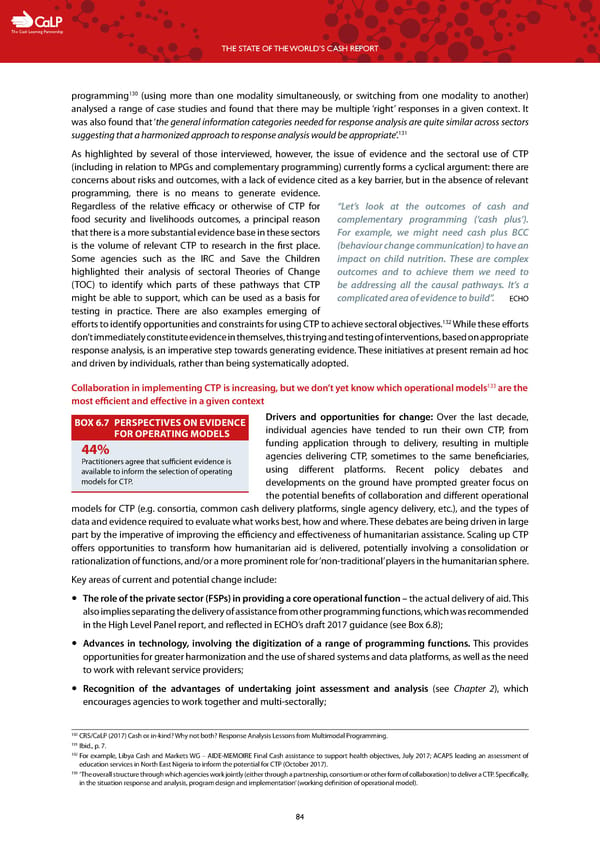C The Cash Learning Partnership THE STATE OF THE WORLD’S CASH REPORT 130 programming (using more than one modality simultaneously, or switching from one modality to another) analysed a range of case studies and found that there may be multiple ‘right’ responses in a given context. It was also found that ‘the general information categories needed for response analysis are quite similar across sectors suggesting that a harmonized approach to response analysis would be appropriate’.131 As highlighted by several of those interviewed, however, the issue of evidence and the sectoral use of CTP (including in relation to MPGs and complementary programming) currently forms a cyclical argument: there are concerns about risks and outcomes, with a lack of evidence cited as a key barrier, but in the absence of relevant programming, there is no means to generate evidence. Regardless of the relative efficacy or otherwise of CTP for “Let’s look at the outcomes of cash and food security and livelihoods outcomes, a principal reason complementary programming (‘cash plus’). that there is a more substantial evidence base in these sectors For example, we might need cash plus BCC is the volume of relevant CTP to research in the first place. (behaviour change communication) to have an Some agencies such as the IRC and Save the Children impact on child nutrition. These are complex highlighted their analysis of sectoral Theories of Change outcomes and to achieve them we need to (TOC) to identify which parts of these pathways that CTP be addressing all the causal pathways. It’s a might be able to support, which can be used as a basis for complicated area of evidence to build”. ECHO testing in practice. There are also examples emerging of 132 efforts to identify opportunities and constraints for using CTP to achieve sectoral objectives. While these efforts don’t immediately constitute evidence in themselves, this trying and testing of interventions, based on appropriate response analysis, is an imperative step towards generating evidence. These initiatives at present remain ad hoc and driven by individuals, rather than being systematically adopted. 133 Collaboration in implementing CTP is increasing, but we don’t yet know which operational models are the most efficient and effective in a given context BOX 6.7 PERSPECTIVES ON EVIDENCE Drivers and opportunities for change: Over the last decade, FOR OPERATING MODELS individual agencies have tended to run their own CTP, from 44% funding application through to delivery, resulting in multiple Practitioners agree that sufficient evidence is agencies delivering CTP, sometimes to the same beneficiaries, available to inform the selection of operating using different platforms. Recent policy debates and models for CTP. developments on the ground have prompted greater focus on the potential benefits of collaboration and different operational models for CTP (e.g. consortia, common cash delivery platforms, single agency delivery, etc.), and the types of data and evidence required to evaluate what works best, how and where. These debates are being driven in large part by the imperative of improving the efficiency and effectiveness of humanitarian assistance. Scaling up CTP offers opportunities to transform how humanitarian aid is delivered, potentially involving a consolidation or rationalization of functions, and/or a more prominent role for ‘non-traditional’ players in the humanitarian sphere. Key areas of current and potential change include: — The role of the private sector (FSPs) in providing a core operational function – the actual delivery of aid. This also implies separating the delivery of assistance from other programming functions, which was recommended in the High Level Panel report, and reflected in ECHO’s draft 2017 guidance (see Box 6.8); — Advances in technology, involving the digitization of a range of programming functions. This provides opportunities for greater harmonization and the use of shared systems and data platforms, as well as the need to work with relevant service providers; — Recognition of the advantages of undertaking joint assessment and analysis (see Chapter 2), which encourages agencies to work together and multi-sectorally; 130 CRS/CaLP (2017) Cash or in-kind? Why not both? Response Analysis Lessons from Multimodal Programming. 131 Ibid., p. 7. 132 For example, Libya Cash and Markets WG – AIDE-MEMOIRE Final Cash assistance to support health objectives, July 2017; ACAPS leading an assessment of education services in North East Nigeria to inform the potential for CTP (October 2017). 133 ‘The overall structure through which agencies work jointly (either through a partnership, consortium or other form of collaboration) to deliver a CTP. Specifically, in the situation response and analysis, program design and implementation’ (working definition of operational model). 84
 The State of the World's Cash | Full Report Page 85 Page 87
The State of the World's Cash | Full Report Page 85 Page 87